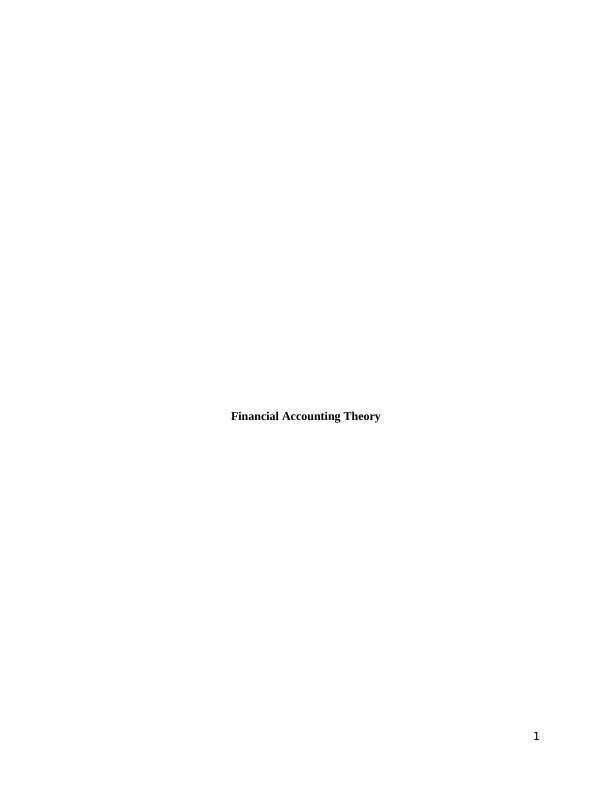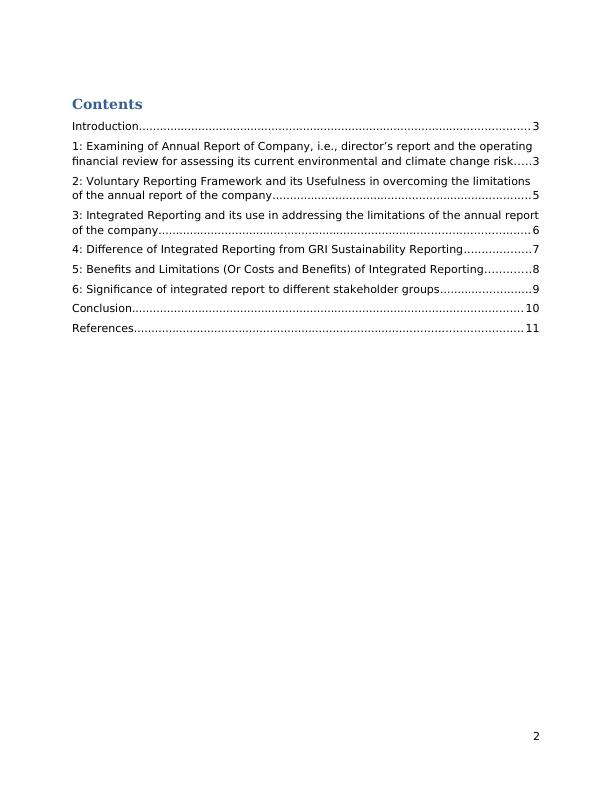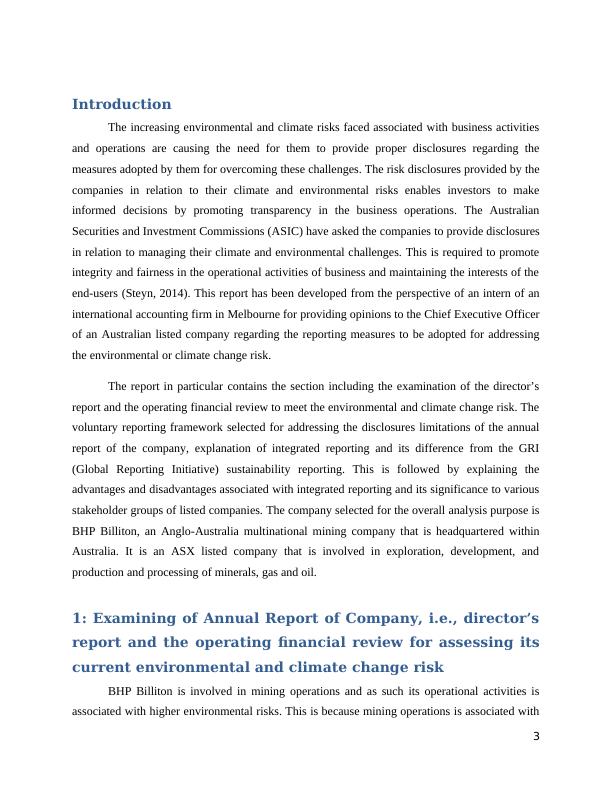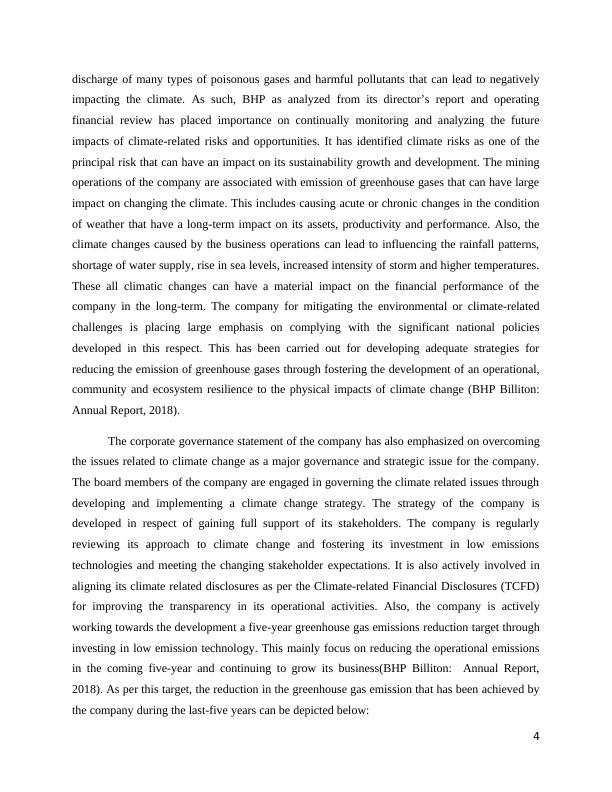Examining Annual Report for Climate Change Risk
Added on 2022-12-30
14 Pages3263 Words64 Views
Financial Accounting Theory
1
1

Contents
Introduction................................................................................................................ 3
1: Examining of Annual Report of Company, i.e., director’s report and the operating
financial review for assessing its current environmental and climate change risk.....3
2: Voluntary Reporting Framework and its Usefulness in overcoming the limitations
of the annual report of the company..........................................................................5
3: Integrated Reporting and its use in addressing the limitations of the annual report
of the company.......................................................................................................... 6
4: Difference of Integrated Reporting from GRI Sustainability Reporting...................7
5: Benefits and Limitations (Or Costs and Benefits) of Integrated Reporting.............8
6: Significance of integrated report to different stakeholder groups..........................9
Conclusion................................................................................................................ 10
References............................................................................................................... 11
2
Introduction................................................................................................................ 3
1: Examining of Annual Report of Company, i.e., director’s report and the operating
financial review for assessing its current environmental and climate change risk.....3
2: Voluntary Reporting Framework and its Usefulness in overcoming the limitations
of the annual report of the company..........................................................................5
3: Integrated Reporting and its use in addressing the limitations of the annual report
of the company.......................................................................................................... 6
4: Difference of Integrated Reporting from GRI Sustainability Reporting...................7
5: Benefits and Limitations (Or Costs and Benefits) of Integrated Reporting.............8
6: Significance of integrated report to different stakeholder groups..........................9
Conclusion................................................................................................................ 10
References............................................................................................................... 11
2

Introduction
The increasing environmental and climate risks faced associated with business activities
and operations are causing the need for them to provide proper disclosures regarding the
measures adopted by them for overcoming these challenges. The risk disclosures provided by the
companies in relation to their climate and environmental risks enables investors to make
informed decisions by promoting transparency in the business operations. The Australian
Securities and Investment Commissions (ASIC) have asked the companies to provide disclosures
in relation to managing their climate and environmental challenges. This is required to promote
integrity and fairness in the operational activities of business and maintaining the interests of the
end-users (Steyn, 2014). This report has been developed from the perspective of an intern of an
international accounting firm in Melbourne for providing opinions to the Chief Executive Officer
of an Australian listed company regarding the reporting measures to be adopted for addressing
the environmental or climate change risk.
The report in particular contains the section including the examination of the director’s
report and the operating financial review to meet the environmental and climate change risk. The
voluntary reporting framework selected for addressing the disclosures limitations of the annual
report of the company, explanation of integrated reporting and its difference from the GRI
(Global Reporting Initiative) sustainability reporting. This is followed by explaining the
advantages and disadvantages associated with integrated reporting and its significance to various
stakeholder groups of listed companies. The company selected for the overall analysis purpose is
BHP Billiton, an Anglo-Australia multinational mining company that is headquartered within
Australia. It is an ASX listed company that is involved in exploration, development, and
production and processing of minerals, gas and oil.
1: Examining of Annual Report of Company, i.e., director’s
report and the operating financial review for assessing its
current environmental and climate change risk
BHP Billiton is involved in mining operations and as such its operational activities is
associated with higher environmental risks. This is because mining operations is associated with
3
The increasing environmental and climate risks faced associated with business activities
and operations are causing the need for them to provide proper disclosures regarding the
measures adopted by them for overcoming these challenges. The risk disclosures provided by the
companies in relation to their climate and environmental risks enables investors to make
informed decisions by promoting transparency in the business operations. The Australian
Securities and Investment Commissions (ASIC) have asked the companies to provide disclosures
in relation to managing their climate and environmental challenges. This is required to promote
integrity and fairness in the operational activities of business and maintaining the interests of the
end-users (Steyn, 2014). This report has been developed from the perspective of an intern of an
international accounting firm in Melbourne for providing opinions to the Chief Executive Officer
of an Australian listed company regarding the reporting measures to be adopted for addressing
the environmental or climate change risk.
The report in particular contains the section including the examination of the director’s
report and the operating financial review to meet the environmental and climate change risk. The
voluntary reporting framework selected for addressing the disclosures limitations of the annual
report of the company, explanation of integrated reporting and its difference from the GRI
(Global Reporting Initiative) sustainability reporting. This is followed by explaining the
advantages and disadvantages associated with integrated reporting and its significance to various
stakeholder groups of listed companies. The company selected for the overall analysis purpose is
BHP Billiton, an Anglo-Australia multinational mining company that is headquartered within
Australia. It is an ASX listed company that is involved in exploration, development, and
production and processing of minerals, gas and oil.
1: Examining of Annual Report of Company, i.e., director’s
report and the operating financial review for assessing its
current environmental and climate change risk
BHP Billiton is involved in mining operations and as such its operational activities is
associated with higher environmental risks. This is because mining operations is associated with
3

discharge of many types of poisonous gases and harmful pollutants that can lead to negatively
impacting the climate. As such, BHP as analyzed from its director’s report and operating
financial review has placed importance on continually monitoring and analyzing the future
impacts of climate-related risks and opportunities. It has identified climate risks as one of the
principal risk that can have an impact on its sustainability growth and development. The mining
operations of the company are associated with emission of greenhouse gases that can have large
impact on changing the climate. This includes causing acute or chronic changes in the condition
of weather that have a long-term impact on its assets, productivity and performance. Also, the
climate changes caused by the business operations can lead to influencing the rainfall patterns,
shortage of water supply, rise in sea levels, increased intensity of storm and higher temperatures.
These all climatic changes can have a material impact on the financial performance of the
company in the long-term. The company for mitigating the environmental or climate-related
challenges is placing large emphasis on complying with the significant national policies
developed in this respect. This has been carried out for developing adequate strategies for
reducing the emission of greenhouse gases through fostering the development of an operational,
community and ecosystem resilience to the physical impacts of climate change (BHP Billiton:
Annual Report, 2018).
The corporate governance statement of the company has also emphasized on overcoming
the issues related to climate change as a major governance and strategic issue for the company.
The board members of the company are engaged in governing the climate related issues through
developing and implementing a climate change strategy. The strategy of the company is
developed in respect of gaining full support of its stakeholders. The company is regularly
reviewing its approach to climate change and fostering its investment in low emissions
technologies and meeting the changing stakeholder expectations. It is also actively involved in
aligning its climate related disclosures as per the Climate-related Financial Disclosures (TCFD)
for improving the transparency in its operational activities. Also, the company is actively
working towards the development a five-year greenhouse gas emissions reduction target through
investing in low emission technology. This mainly focus on reducing the operational emissions
in the coming five-year and continuing to grow its business(BHP Billiton: Annual Report,
2018). As per this target, the reduction in the greenhouse gas emission that has been achieved by
the company during the last-five years can be depicted below:
4
impacting the climate. As such, BHP as analyzed from its director’s report and operating
financial review has placed importance on continually monitoring and analyzing the future
impacts of climate-related risks and opportunities. It has identified climate risks as one of the
principal risk that can have an impact on its sustainability growth and development. The mining
operations of the company are associated with emission of greenhouse gases that can have large
impact on changing the climate. This includes causing acute or chronic changes in the condition
of weather that have a long-term impact on its assets, productivity and performance. Also, the
climate changes caused by the business operations can lead to influencing the rainfall patterns,
shortage of water supply, rise in sea levels, increased intensity of storm and higher temperatures.
These all climatic changes can have a material impact on the financial performance of the
company in the long-term. The company for mitigating the environmental or climate-related
challenges is placing large emphasis on complying with the significant national policies
developed in this respect. This has been carried out for developing adequate strategies for
reducing the emission of greenhouse gases through fostering the development of an operational,
community and ecosystem resilience to the physical impacts of climate change (BHP Billiton:
Annual Report, 2018).
The corporate governance statement of the company has also emphasized on overcoming
the issues related to climate change as a major governance and strategic issue for the company.
The board members of the company are engaged in governing the climate related issues through
developing and implementing a climate change strategy. The strategy of the company is
developed in respect of gaining full support of its stakeholders. The company is regularly
reviewing its approach to climate change and fostering its investment in low emissions
technologies and meeting the changing stakeholder expectations. It is also actively involved in
aligning its climate related disclosures as per the Climate-related Financial Disclosures (TCFD)
for improving the transparency in its operational activities. Also, the company is actively
working towards the development a five-year greenhouse gas emissions reduction target through
investing in low emission technology. This mainly focus on reducing the operational emissions
in the coming five-year and continuing to grow its business(BHP Billiton: Annual Report,
2018). As per this target, the reduction in the greenhouse gas emission that has been achieved by
the company during the last-five years can be depicted below:
4

End of preview
Want to access all the pages? Upload your documents or become a member.
Related Documents
Accounting vs Finance Degree:lg...
|20
|3861
|23
Accounting & Financial Management - BHP Billiton limited.lg...
|19
|3403
|14
Corporate Sustainability Reporting and CSR in Mining Industrylg...
|11
|2103
|477
Importance of Sustainability Reporting: A Critical Review and Evaluation of BHP Billiton's Sustainability Report for 2017lg...
|11
|2645
|385
Application of Sustainability and Corporate Governance in BHP Billitonlg...
|11
|2522
|260
BHP Billiton's Corporate Responsibility in Controlling Climate Changelg...
|12
|2385
|53
